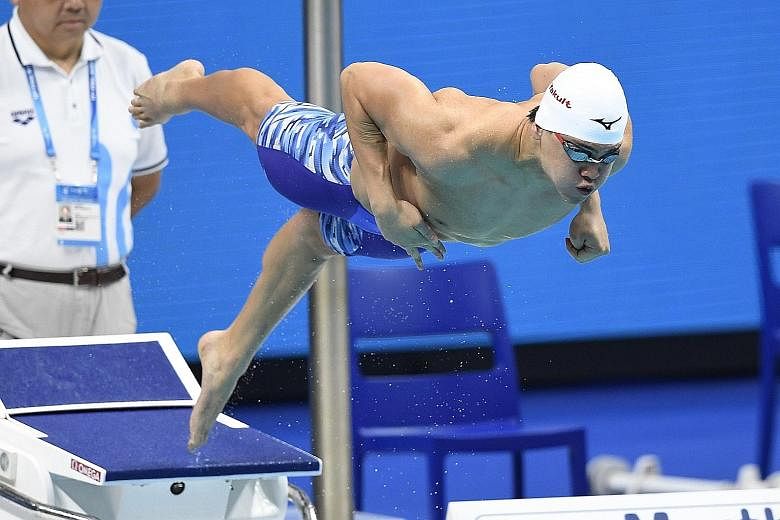One could not find a more apt location as Joseph Schooling's historic bid for the 100m butterfly world record begins today.
Budapest's Danube Arena, venue of this year's swimming World Championships, sits along the Danube River, which has a name that originates from a Roman river god.
One man and three women have already carved their names into the sport's archives with their individual world records and Schooling hopes to add his to that list.
There is cause for his optimism. He has the fastest time in a textile suit, 50.39 seconds, set at last year's Rio Olympics where he won gold. One of the men he beat then in Brazil, American Michael Phelps, owns the world record of 49.82sec, which was set in a now-banned supersuit.
Schooling's biomechanist Ryan Hodierne, who is instrumental in breaking down statistics - including stroke rate and distance per stroke, splits, breathing patterns, reaction time, and velocity in the water - said the 22-year-old has every chance of lowering Phelps' mark.
He told The Straits Times: "Jo's incredibly good at generating speed. He's stronger now than he was before Rio. He's almost getting more distance per stroke now (it ranged between 2m and 2.22m per stroke in the Rio final) and he's more efficient. That's come with the added strength."
Before this week, Schooling's personal best in the 50m fly was 23.25sec from the 2015 World Championships in Kazan, Russia. He lowered it to 22.93sec in Hungary.
In Rio, Hodierne had set Schooling a target of 23.60sec for the first 50m - Schooling swam 23.64sec and 26.75sec for the return leg - to maximise the Singaporean's preference for a quick first lap.
By comparison, Phelps' world-record splits at the 2009 World Championships in Rome were 23.36sec and 26.46sec.
Hodierne said: "We can start re-looking Jo's front-end speed to go fast but still have enough for the second 50m. What is that magic number now? Ultimately we want him to be faster on the way back as well."
Schooling's former mentor Sergio Lopez feels his protege is still adjusting to the post-Olympic hangover but challenged anyone to write the Rio champion off.
Schooling has the year's second-fastest time of 50.96sec, behind American Caeleb Dressel (50.87sec).
Lopez said: "At one point, he will deliver. He wants to do it. Will be now or at another meet but I believe in him and I believe Joseph Schooling will be a world record holder at one point.
"I think it is more realistic now for Joseph to break the world record than for Caeleb this year. Caeleb was rested and swam a best time and still is a second off the record. Joseph's best time from last year is less than half a second from it."
One area that Schooling's team has examined is tweaking his breathing patterns to shave the hundredths of seconds that separate these world-class swimmers.
In the 50m fly semi-finals, Schooling took two breaths, with 30m and 20m to go.
In the final, he held his breath till there was just 16m to go. It was on his 10th stroke.
Keeping his head down was crucial, noted Hodierne, as it minimised any disruption to the position of a swimmer's hips.
"For a short-axis stroke like the butterfly or breaststroke, you want to try and keep the hips as high as possible. If they are up and you're driving forward, it gives the perception that we are swimming downhill."
In Rio, this was especially key for Schooling, who at 1.84m was shorter than the 1.93m-tall Phelps, whose longer frame was more stable in the water.
Hodierne said: "One benefit Phelps had was a very long torso. When he breathed, he kept a very small undulation, so the angle he was moving through was much smaller than someone with a shorter torso.
"It didn't disrupt his stroke and he could breath on every stroke."
The experiment during the 50m fly events were helpful but could not be mirrored exactly in the 100m race as Schooling needed something in reserve after he made the turn, said Hodierne.
He added that it was about finding what Schooling was most comfortable with, yet maximising every stroke to deliver the optimum performance. He took 35 strokes in the Rio final.
The absence of Phelps, who retired after Rio, does not make things any easier though.
Besides Dressel, Chad le Clos, who is seeking a hat-trick of 100m fly world titles and was joint-second with Phelps and Laszlo Cseh in Brazil, has upped his game. The South African beat hometown hero Cseh to win a thrilling 200m fly final on Wednesday.
Schooling was a relatively unknown quantity before the Rio Games but all his rivals are now familiar with him.
Hodierne, who had previously worked with le Clos, said: "People know the type of strategy Jo swims, what favours him."
Yet for the scientific breakdown he has done, the 33-year-old South African has no answer for what lies underneath Schooling's chest.
He said: "In Rio, we tried to set the first 50m up so he could at least maintain and not lose speed on the second 50m. What he did after that, breaking out half a body length ahead of the rest, he was like, 'This is mine' and he just went for the prize.
"I can't measure that type of thing. I didn't think a sub-50.58sec (the previous Olympic record set by Phelps at the 2008 Beijing Games) swim was even possible. He just proved me wrong there."

